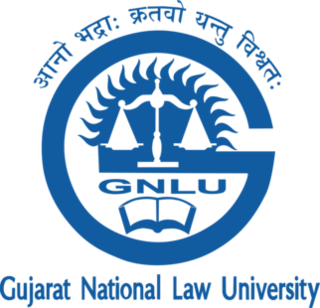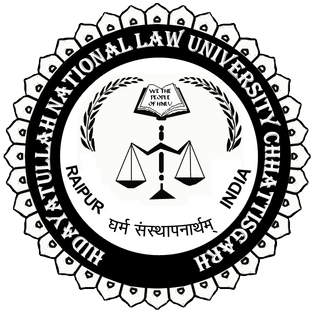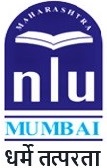
National Law School of India University (NLSIU), or simply National Law School(NLS), is a public law school and a National Law University in Bangalore. The university was established by the NLSIU Act of 1986, which was passed by the Karnataka Legislative Assembly.
Joint Entrance Examination – Advanced (JEE-Advanced), is an academic examination held annually in India that tests the skills and knowledge of the applicants in physics, chemistry and maths. It is organised by one of the seven zonal IITs under the guidance of the Joint Admission Board (JAB) on a round-robin rotation pattern for the qualifying candidates of the JEE-Main. It used to be the sole prerequisite for admission to the Indian Institutes of Technology bachelor's programs before the introduction of UCEED, Online B.S. and Olympiad entries, but seats through these new mediums are very low.

The West Bengal National University of Juridical Sciences is a National Law University (NLU) located in Bidhannagar, Kolkata, West Bengal, India. In 2023, it was ranked 4th among law colleges in India by National Institutional Ranking Framework and 2nd by India Today. It comes under the exclusive chancellorship and purview of the [Chief Justice of India].

National Law University, Jodhpur (NLUJ) is a public law school and a National Law University established under the National Law University, Jodhpur, Act, 1999 enacted by the Rajasthan State Legislature. The university was established for the advancement of learning, teaching, research and diffusion of knowledge in the field of law. It is one of the autonomous law schools in India.

The National Academy of Legal Studies and Research (NALSAR), is a public law school and a National Law University located in Shamirpet, Hyderabad, Telangana, India, and is considered as one of the best law schools in India.

The Gujarat National Law University (GNLU) is an eminent public law school and a National Law University established under the Gujarat National Law University Act, 2003 in the state of Gujarat. The university is located at Gandhinagar, which is the capital of Gujarat and is located 23 kilometers north of the city of Ahmedabad. The statute provides for the Chief Justice of India or a Senior Supreme Court Judge to serve as the Visitor of the university.

The National University of Advanced Legal Studies (NUALS) / NLU Kochi is a public law school and a National Law University located in Kochi, India. It is the first and only National Law University (NLU) in the State of Kerala and is one of the 26 NLUs in India. Admissions to the university are done on the basis of the Common Law Admission Test (CLAT) which is one among the Top 10 hardest entrance examinations of India.
The Joint Entrance Examination (JEE) is an engineering entrance assessment conducted for admission to various engineering colleges in India. It is constituted by two different examinations: the JEE-Main and the JEE-Advanced.

National Law Universities (NLU) are public law schools in India, founded pursuant to the second-generation reforms for legal education sought to be implemented by the Bar Council of India. The first NLU was the National Law School of India University aka NLS/NLU Bangalore which admitted its first batch in 1988. Since then, most of the states in India have NLUs. Currently there are 27 NLUs across the country out of which one is an off-centre campus of NLU Gandhinagar, GNLU SILVASSA Campus. Since the inception of NLUs, these law schools have continuously been ranked as India's most and world's one of the most prestigious and premier law schools by various agencies and are also referred as IITs of Legal Education.

Hidayatullah National Law University (HNLU) is a public law school and a National Law University located in New Raipur, Chhattisgarh, India Named after the former Chief Justice of India, Justice Mohammad Hidayatullah. It is one of the autonomous law schools in India and sixth in the series of such national law schools. It was established as a Centre for legal excellence by the Government of Chhattisgarh under the Hidayatullah National University of Law, Chhattisgarh, Act. The university offers a B.A. LL.B. (Hons.) integrated Program, an L.L.M. Program, and a PhD Course.

Dr. Ram Manohar Lohiya National Law University, also known as RMLNLU or NLU Lucknow is a public law school and a National Law University located in Lucknow, Uttar Pradesh, India. It was established as Dr. Ram Manohar Lohiya National Law Institute undergraduate and post-graduate legal education, later in 2006 it was renamed as RMLNLU to give a NLU touch to its name. It is one among the 26 NLUs across India and the only one in Uttar Pradesh. It is among the top 10 National Law Universities / Law colleges in India.

Chanakya National Law University (CNLU) is a public law school and a National Law University in Patna, Bihar, India. It was established in 2006 by the Government of Bihar as a public university dedicated to the field of legal education. The Chief Justice of Patna High Court is the ex officio chancellor of the university. It is one of the autonomous law schools in India. The campus is bogus right near the heart of the city in the Mithapur area and has an area of approximately 18 Acres.

National Law University, Delhi (NLUD) is one of the National Law Universities in India, situated in Sector-14 of Dwarka, Delhi. It offers courses at the undergraduate and postgraduate levels. As one of the national law schools in India, NLUD is built on the five-year law degree model proposed and implemented by the Bar Council of India. The National Law University Act, 2007, provides for the Chief Justice of India to be the university's visitor, the Chief Justice of the High Court of Delhi to function as the university's chancellor, and its vice-chancellor to function as the chief administrator.

National Law University Odisha (NLUO) is a public law school and a National law University in India located at Cuttack, Odisha. It was established in 2008 under the National Law University Odisha Act, commencing its first batch from July 2009. The institute offers undergraduate, BBA/LL.B., and post-graduate courses in law. It is one among the 25 NLUs in the country.
Legal education in India generally refers to the education of lawyers before entry into practice. Legal education in India is offered at different levels by the traditional universities and the specialised law universities and schools only after completion of an undergraduate degree or as an integrated degree.

National University of Study and Research in Law (NUSRL) is a National Law University located in Ranchi, Jharkhand, India. It was established by a legislative act, by the State of Jharkhand as the fourteenth National Law University of India. The statute provides for the Chief Justice of India or a Senior Supreme Court Judge to serve as the Visitor of the university.
The National Eligibility-cum-Entrance Test (Undergraduate) or NEET (UG), formerly the All India Pre-Medical Test (AIPMT), is an all India pre-medical entrance test for students who wish to pursue undergraduate medical (MBBS), dental (BDS) and AYUSH (BAMS, BUMS, BHMS, etc.) courses in government and private institutions in India and also, for those intending to pursue primary medical qualification abroad.

Maharashtra National Law University, Mumbai is a National Law University located at Mumbai, Maharashtra, India.

Maharashtra National Law University, Nagpur (MNLU) is a National Law University and a public law school established by the government through the Maharashtra National Law University Act. The university is the 19th National Law University established in India and is located in the Orange City of Nagpur, Maharashtra. Hon'ble Supreme Court Justice Bhushan Ramkrishna Gavai serves as the chancellor of the institution.















